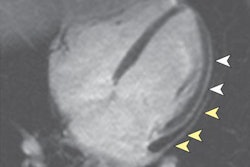
Myocardial perfusion cardiovascular MRI cannot top angiography and fractional flow reserve (FFR) measurements in determining which symptomatic patients with coronary artery disease risk factors need revascularization, according to a study published June 20 in the New England Journal of Medicine.
The results come from the international, multicenter Myocardial Perfusion CMR Versus Angiography and FFR to Guide the Management of Patients With Stable Coronary Artery Disease (MR-INFORM) trial, which also found that cardiovascular MRI was no better than the angiography-FFR approach in predicting major adverse cardiac events at one-year follow-up.
"Current guidelines on the management of the care of patients with suspected coronary artery disease separate diagnostic strategies from therapeutic strategies owing to a lack of evidence comparing combined diagnostic and therapeutic pathways," wrote researchers led by Dr. Eike Nagel from Goethe University Frankfurt in Germany. "[This] trial closes this knowledge gap by comparing two frequently used, well-defined, standardized, and validated clinical management strategies."
When clinicians need to evaluate symptomatic patients with coronary artery disease risk factors such as smoking, diabetes, hypertension, hyperlipidemia, or family history of the disease, they have two primary strategies. One approach to confirm coronary artery disease is invasive angiography, which assesses FFR to determine the need for revascularization. Another option is myocardial perfusion cardiovascular MRI, which offers high concordance with FFR for ischemia diagnosis and possible revascularization.
"However, data are lacking on the effectiveness of a cardiovascular MRI-based strategy to guide coronary revascularization as compared with an invasive angiography-based strategy," the authors added. "We hypothesized that an initial management strategy based on myocardial perfusion cardiovascular MRI would be noninferior to a strategy guided by invasive angiography and FFR in terms of major adverse cardiac events."
The current trial included 918 eligible patients, age 18 years or older, from 16 sites in the U.K., Portugal, Germany, and Australia. The subjects presented with typical angina symptoms, and either two or more cardiovascular risk factors or a positive exercise treadmill test between December 2010 and August 2015. The researchers created a cardiovascular MRI group with 454 patients whose revascularization was based on the modality's results, and an FFR group with 464 patients whose follow-up revascularization depended, in part, on angiography findings.
In the end, the researchers noted no statistically significant difference between patients in the cardiovascular MRI group who were recommended for revascularization and patients in the FFR group who met the criteria for revascularization (p = 0.11). In addition, significantly more patients ultimately underwent revascularization in the FFR group, compared with cardiovascular MRI patients, meaning angiography and FFR were more effective in confirming the need for revascularization than MRI (p = 0.005).
For major adverse cardiac events at one-year follow-up, the team found no difference in predicting outcome between the two approaches.
| Cardiac MRI vs. angiography/FFR in predicting cardiac events | |||
| Cardiovascular MRI | Angiography with FFR | p-value | |
| Recommended for revascularization | 40% | 46% | 0.11 |
| Underwent revascularization | 36% | 45% | 0.005* |
| Cardiac event after 1 year | 3.6% | 3.7% | 0.0 |
"In patients with stable angina and risk factors for coronary artery disease, an initial management strategy guided by myocardial perfusion cardiovascular MRI was noninferior to a strategy of invasive angiography and FFR with regard to major adverse cardiac events at 12 months," the authors wrote.



.fFmgij6Hin.png?auto=compress%2Cformat&fit=crop&h=100&q=70&w=100)




.fFmgij6Hin.png?auto=compress%2Cformat&fit=crop&h=167&q=70&w=250)











